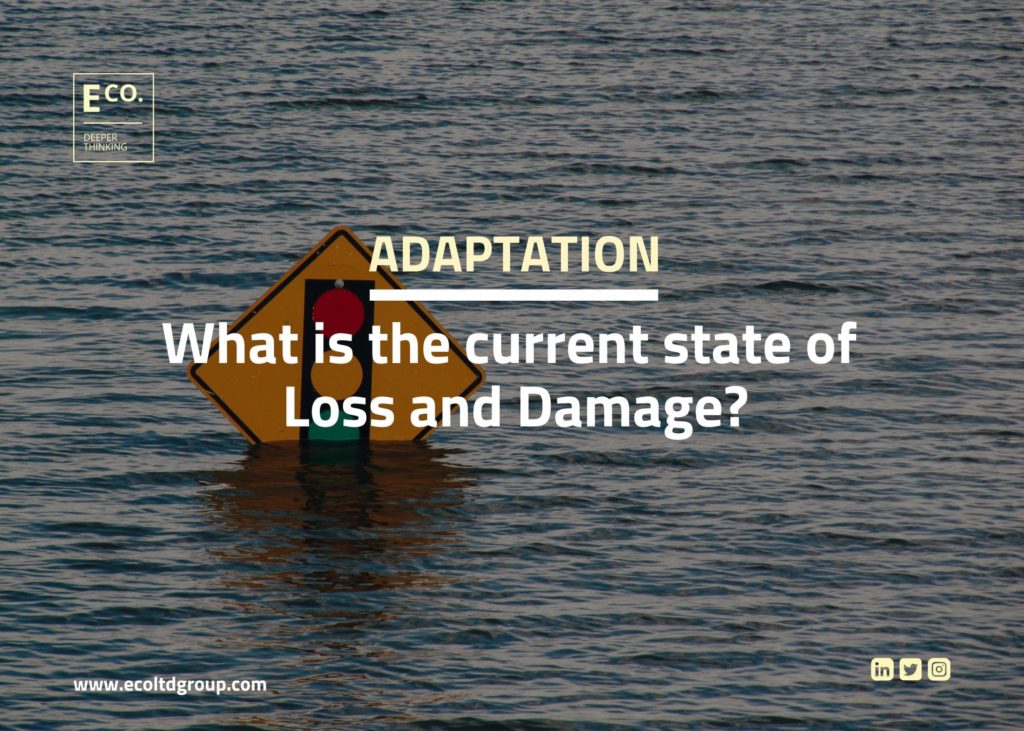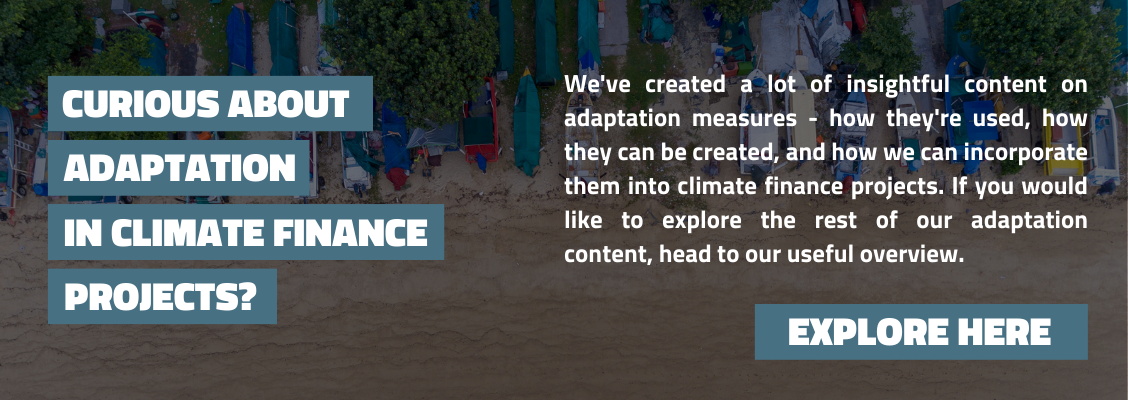What is the current state of Loss and Damage?
26 April 2023, Category: All insights, News, Tags: adaptation, climate change, climate finance, COP27, cop28, loss and damage, UNFCCC

By Marcus Arcanjo
‘Loss and Damage’ has been the hot topic at the forefront of climate change discussions in recent years. While the term lacks an official, formal definition, it typically refers to the “destructive impacts of climate change that cannot be, or have not been, avoided by mitigation or adaptation.” It is also used as a general term to describe the UN climate negotiations, especially the policies and plans discussed, to address climate impacts.
Calls for Loss and Damage financial support for climate-vulnerable nations were met with the agreed establishment of a Loss and Damage Fund at COP27 in 2022. However, the Fund and the rules governing it are yet to be created, so the adequacy of such a financial mechanism remains a contentious issue.
In this article, we answer four key questions:
- How has Loss and Damage been perceived in the past?
- What led to the establishment of a standalone Loss and Damage Fund?
- What needs to be in place to create an effective financing mechanism?
- What are the significant challenges ahead?
A brief history of Loss and Damage
Until now, no international financing specific to loss and damage has been available under the United Nations Framework. For many countries, especially those most vulnerable to climate change, finding a solution to ensure financial assistance for climate-related losses is a matter of accountability. Many of these countries historically contributed negligibly to global greenhouse gas emissions but regularly experience devastating consequences of extreme weather events. The enormous costs associated with these events, which climate-vulnerable countries, in general, did little to cause, create additional financial burdens in countries with limited adaptive capacity and resources.
To learn more about the costs associated with climate change and the financing needed to combat it, read the first blog in our adaptation series here.
A specific loss and damage fund was first called for by the Alliance of Small Islands States (AOSIS) in 1991, highlighting the critical need for an international financial mechanism that provides for the most vulnerable experiencing the losses and damages associated with the impacts of climate change. For years the calls landed on deaf ears as developed countries were concerned about how such a mechanism could be operationalised and the legal ramifications associated with becoming obligated to provide financial compensation. They believed this could lead to opened-ended liability any time an event that causes destruction occurs.
Instead, more recently, capacity building and knowledge support were made available. Loss and damage was officially recognised in UN negotiations at COP19 in 2013, where the Warsaw International Mechanism (WIM) for Loss and Damage was established to:
- Enhance knowledge and understanding of risk management approaches to address loss and damage;
- Strengthen dialogue, coordination, coherence and synergies among relevant stakeholders;
- Enhance action and support, including finance, technology and capacity-building.
At COP25 in Madrid in 2019, parties agreed to establish The Santiago Network on Loss and Damage (SNLD) – a technical assistance body that could support countries to navigate the complex world of funding arrangements and help with the implementation of relevant approaches for averting, minimising and addressing loss and damage at the local, national and regional level. However, neither of these decisions led directly to the establishment of a financing mechanism.
Agreeing to a standalone fund – a breakthrough moment
In the run-up to COP27, and throughout most of the conference, the likelihood of an agreement for a new, separate financing mechanism for Loss and Damage was low. While momentum around the topic had gathered pace for a long time, major economies, and emitters, such as the US, EU and UK had reservations that seemed too significant to overcome. From the outset, many countries, including small island developing states (SIDS) and Pakistan – still reeling from the devastating floods in 2022 – continued the pressure which led to the agreement of a specific agenda item focused on loss and damage. This created an opportunity for technical discussions relating to the current gaps in the financing architecture. Nonetheless, even deep into the second week of the conference, very few people expected a positive outcome and final decision.
It wasn’t until a sudden change of position by the European Union late into the evening of the penultimate night that things shifted. The EU said they would support the establishment of a fund based on several conditions. This single move suddenly changed the momentum of the conference, leading to other holdouts also deciding to support a standalone fund.
Parties to the UNFCCC took the ground-breaking decision to establish new funding arrangements, as well as a dedicated fund, to assist developing countries in responding to loss and damage, including with a focus on addressing loss and damage by providing and assisting in mobilising new and additional resources, and that these new arrangements complement and include sources, funds, processes and initiatives under and outside the Convention and the Paris Agreement.
Now a fund was agreed upon, parties have the unenviable task of deciding exactly how it will work. To do this, governments also agreed to establish a ‘Transitional Committee’ to make recommendations on how to operationalize both the new funding arrangements and the fund by COP28 in November and December 2023.
The challenge: Creating an effective financing mechanism
The Transitional Committee is made up of 24 members, including 14 from developing countries, and must consider:
- The current landscape of institutions, including global, regional and national, that are funding activities related to addressing loss and damage, and ways in which coherence, coordination and synergies among them can be enhanced;
- The gaps within that current landscape, including the types of gap, such as relating to speed, eligibility, adequacy and access to finance, noting that these may vary depending on the challenge, such as climate-related emergencies, sea level rise, displacement, relocation, migration, insufficient climate information and data, or the need for climate-resilient reconstruction and recovery;
- The priority gaps for which solutions should be explored;
- The most effective ways in which to address the gaps, especially for the most vulnerable populations and the ecosystems on which they depend;
- Potential sources of funding, recognizing the need for support from a wide variety of sources, including innovative sources.
The first meeting of the Transitional Committee took place in March 2023, where they agreed to the Workplan going forward to COP28. This included the addition of a fourth Committee meeting (where previously there were only three) and potential topics for intersessional workshops.
The main focus of this meeting was to better understand the current landscape of financing architecture with multiple major organisations giving presentations on their work and how it relates to tackling climate change and loss and damage.
The World Bank highlighted their ability to tackle both immediate crises and slow onset events. They have tools such as Catastrophe Deferred Drawdowns (Cat DDO) which provides immediate liquidity to countries to address shocks related to natural disasters and/or health-related events and works as early financing while other funds can be mobilised. They also intend to have all of their projects aligned with the Paris Agreement by July 1.
The Adaptation Fund pointed to the fact that approximately 25% of their portfolio is already dedicated to early warning systems and disaster risk reduction and their country-driven approach accommodates circumstances rather than favours sectors. However, they noted that they have no explicit mandate to support loss and damage and this support would require significant resources and speed of implementation.
Other organisations more closely aligned to development and disaster response rather than climate also provided fascinating presentations. For example, the World Food Programme noted their significant experience, deep field presence, and knowledge of local contexts. Their focus on preparedness and forecasting has previously yielded significant benefits, noting that forecast-based financing (FBF) leads to cost saving over a 20-year period. The cost of ‘false alarms’ – that is, forecast warnings that do not lead to disaster – are significantly less than the cost of waiting for disaster to strike and then taking a reactive stance. FBF limits damages caused by natural hazards on vulnerable people (75%) and assets (50%) of damage reduction on crops and cattle.
Other presentations came from the Green Climate Fund, Global Environment Facility, International Federation of the Red Cross, UN International Organization for Migration, UNEP Financial Initiative, UN Office for Disaster Risk Reduction, and UN Office for the Coordination of Humanitarian Affairs.
While there is certainly some overlap between the work these organisations do, especially in the area of disaster risk reduction, and the requirement for loss and damage, it appears clear that no single organisation is ideally placed (at least currently) to work in this capacity.
The challenges ahead
While this initial meeting scoped the current financing landscape, there are still many issues that need resolving.
A major challenge is the speed of disbursement necessary for effective loss and damage, especially if an approach is taken that seeks to use existing international funds. For example, the GCF, Adaptation Fund and GEF are all proposal-based financing mechanisms. Often proposals can take well over a year to move through the necessary stages to project approval. Communities experiencing sudden climate-related disasters cannot wait this long for payouts for loss and damage – it must be as close to immediate as possible and even better if it is anticipatory. Moreover, some Committee members suggested the fund must differentiate between the short term (response and relief) and long term (recovery, reconstructions, rehabilitation, resettlements and resilience) and provide support to cover it all.
The financial mechanism to be used must also be carefully debated. Several people, including civil society observers, intervened on this point during the first meeting. The most vulnerable countries will need grants instead of loans to avoid plunging countries into further debt, especially as a result of events they contributed very little to.
Others discussed the ineffectiveness of insurance as a tool, noting that it often does not cover the costs of loss and damage and may come with high premiums that could be unaffordable for developing countries. For example, insurance payouts after Hurricane Maria hit Dominica in 2017 were only 2% when loss and damage equivalent was 224% (USD 930.9 million in damages and USD 380.2 million in losses) – insurance therefore covered less than 1% of the costs. While additional finance was available from the World Bank (USD 40 million), it remained far short of what was required.
The Committee must also answer a number of critical questions before COP28, including:
- Who pays and how much? Presumably this is likely to be the major emitters with financial contributions weighted based on their contribution to global emissions. How will the fund determine how much money is needed?
- What is the money for? What are the conditions and/or triggers necessary for countries to receive a payout? Are they strictly economic losses or are non-economic losses included?
- How will the fund determine whether a disaster is climate-related? For example, a major landslide causing displacement, destruction and even the loss of life could be caused by changes in land use or by excessive rainfall exacerbated by climate change. How will the mechanism differentiate between them? How will it do this at the speed required to be effective?
- Who receives funds? The decision made at COP27 notes that the fund should assist developing countries that are particularly vulnerable to the adverse effects of climate change but there is an element of ambiguity. No doubt some countries will miss out on the resources that feel they meet these criteria.
- How will the fund be governed? Will there be different mechanisms for slow onset climate events such as sea level rise versus rapid onset events?
- How will the fund ensure that money is new and additional rather than simply re-routed from other climate, development and/or humanitarian finance?
With only seven months and three Committee meetings to go before COP28, there is an enormous amount of work needed to move this fund from commitment to reality.

Looking for insight into climate finance? Look no further
Get in touch with our climate finance consultants to discuss a project you’re working on and create successful, fit-for-purpose projects, now and in the future. Email us at: amy@ecoltdgroup.com or find us at the following:
Twitter: @ecoltdnews
LinkedIn: E Co.
Instagram: @ecoltdnews
One Reply
Join the conversation by posting a comment below. You can either use your social account, by clicking on the corresponding icons or simply fill in the form below. All comments are moderated.

[…] have a disproportionate impact on the world’s most vulnerable groups. Because climate change and its impacts are more easily observed and experienced at the local level, local actors are uniquely positioned […]